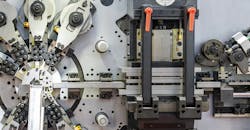Metal stamping describes a range of manufacturing processes, but performing any of them well and achieving market-quality results calls for a concentrated effort that addresses training, production, tool condition, and more. These are some of the best methods for overcoming the particular challenges of the process:
Understand the role of education
Whether you’re a tool-and-die apprentice or someone with decades of industry experience you could benefit from consistent, in-depth training related to your role. The right training will help you address new challenges while gaining the skills to tackle customers’ emerging demands.
At the Manufacturing Innovation, Technology and Job Center in Cleveland, high school students learn metal stamping, laser cutting and other skills that prepare them for future success in manufacturing. The facility is now the headquarters for the Manufacturing Advocacy and Growth Network (MAGNET). People use approximately one-third of the building for manufacturing demonstrations and exhibits.
The hope is that through hands-on experiences and training, young people will break down their preconceived impressions of manufacturing and develop the skills that will lead to well-paying careers. Elsewhere, some companies use technologies like virtual and augmented reality to train metal stampers. Trainees will benefit from seeing checklists and other supporting materials projected onto the equipment they use.
Education is a core element of quality metal stamping. Prioritizing education at the start of and throughout a person’s metal-stamping career is a practical way to improve outcomes.
Improve layout and maintenance
Even the most skilled metal-stamping professionals cannot achieve their desired results if they continually struggle with environmental or equipment-related concerns. For example, leaders at one metal stamping company realized that their current shop layout caused issues that prevented employees from working at their best and raised the risk of injury.
The shop had used open floor space by storing dies in single rows. However, workers frequently rearranged the dies to get what they needed, which caused inventory damage and safety concerns. Changes occurred when the shop invested in a storage rack system that could hold 40,000 pounds of vertical storage per shelf. Getting tools off the floor expanded production capabilities and kept workers safer.
Quality metal stamping results also are easier to achieve if the tools are well-maintained. One option is to use smart sensors and algorithms that predict when problems will occur. Shop managers then have a window to respond before downtime affects production.
In one case, researchers from the University of Aveiro (in Portugal) designed stamping-press algorithms that measured 80 indicators of impending failure. Besides detecting problems, the technology suggested how to optimize production, and the results indicated that the algorithms could have made the press work nearly five hours longer, representing a vast productivity improvement.
Automate to improve quality control
Many business owners recognize that automation is the way forward for companies concerned about quality metal stamping outcomes. That’s because programming and algorithms allow equipment to perform repetitive tasks with fewer (or no) errors. Some users also combine digital algorithms with physical solutions, like robots.
Tesla is an example of the ways that robots can handle metal-stamping tasks. The electric car builder relies on the machines to stamp metal sheets for the front trunks of its Model Y and Model 3 vehicles.
Ford is another automaker that embraces automated metal stamping. Its newly opened South African stamping plant has a fully automated line, allowing the facility to process 272 tons of steel over three shifts at full capacity. The plant includes an advanced scanner to compare the perimeter and surface dimensions of each piece coming off the line to a 3D model stored in a database. While scanning took more than an hour with previous technologies, the current scanner does the job in under three minutes.
Automation is not a quick fix, but it can help manufacturers overcome numerous obstacles. Anyone thinking about implementing it should investigate what options exist and how to use them to enable continuous improvement.
Use enterprise resource planning
Experts say an excessive number of parts tagged for scrap or rework are among the biggest signs a facility struggles with metal stamping quality. A stopped press is another concern because it can indicate issues with the quality of a just-produced product. However, ERP software can target these issues and others.
The software logs all the scrap and rework instances, including the cause and corrective actions taken. If machinists record that data manually, there’s a higher chance of errors. ERP also can contain the data needed to perform inspections after production. Otherwise, the customers could be the ones who spot the flaws, leading to reputational damage.
The ERP also becomes a valuable source of compiled information, helping people trace and track the actual cost of the finished metal-stamping work. Managers can get details about everything from parts costs to quality problems.
Because many ERP platforms are based in the cloud, authorized users can pull the data they need with any internet-enabled device. High accessibility helps them verify information instead of making assumptions that could negatively affect metal stamping quality in the future.
Working through metal stamping challenges takes time. However, setting goals for everyone in the facility to address together is one of the best ways to keep workers motivated and ensure they understand what’s expected. It’s also worth creating goals based on current needs and the organization’s aspirations.
Emily Newton is the Editor-in-Chief of Revolutionized, an online magazine exploring the latest industrial innovations.
About the Author
Emily Newton
Emily Newton is the Editor-in-Chief of Revolutionized, an online magazine exploring the latest industrial innovations.
